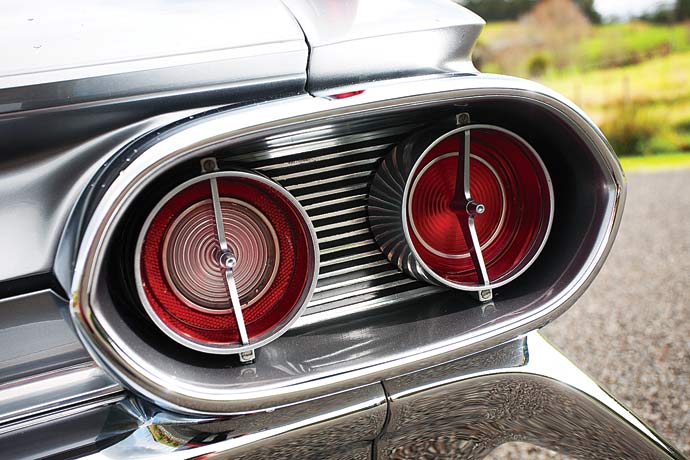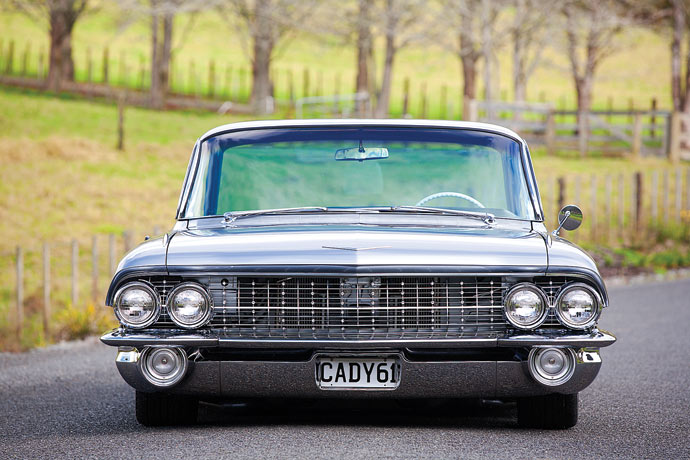data-animation-override>
“Published in NZV8 Issue No. 93”

Whangarei’s Warwick Hales has been a Corvette man for many years. There’s not much he loves more when unwinding from the stress of the working week, than firing up his big-block 1972 Corvette and hitting the road. And it’s not hard to see why. The Vette is a vary rare Baldwin Motion edition with more than enough power to get him into trouble, and drives like a dream.
The only downside is that with a couple of kids, the Vette doesn’t get out as often as it should.
It was with this in mind that he decided perhaps something a little larger, with a back seat, would be the answer to his problems. And they don’t come much larger than a 1961 Cadillac Coupe de Ville.
Warwick found the car already in New Zealand, and thought that while it could do with a bit of a tidy-up, at the time not he wasn’t quite intending for a full bare-metal rebuild. Upon getting the car back home though, the situation became a bit more obvious, and that was that it was in need of some major work.
Luckily for him, he already knew well known Whangarei panel shop owner Louie Berkers, who’d sold off his bustling crash-repair business and had since set up Full Noise Auto Restorations: a business specialising in doing exactly what Warwick was after.
Not only was Louie capable of doing the work on the car, he could also manage the entire build, and liaise with any subcontractors, which made him the perfect man for the job. With any build like this, the relationship between owner and builder is critical, and it’s all too common for things to end badly. In this case though, the two are better mates now than before the build began, and Warwick can’t speak highly enough of Louie’s work, his attention to detail and his project management abilities.
The first thing to be sorted on the build was the body. Louie has tried to forget how much work was involved in stripping the paint off the nearly six-metre-long car, but he knew it had to be done if the DuPont Mazda Aluminium colour paint was ever going to stick. Of course, before Krystal Klear Car Painters could paint the car, Louie worked his magic bringing the body back into a condition better than when it left the factory all those years ago. You’d never know now that there was ever rust or dents in the car, nor that the door gaps were ever out of alignment. The big long quarter-panels are now arrow straight.
While the bodywork was taking place, the chrome from both the exterior and interior was being repaired and re-plated, and that intricate grille re-anodised as well. The number of small parts on a car like this that require attention can never be imagined until you’ve pulled one apart yourself, but such was Louie’s attention to detail that even the parts that go unseen now look as good as those that are in view.
While the car came with a running Cadillac motor, it was wisely decided that it would be a cheaper and easier option to drop a small-block Chev into the engine bay rather than mess about with the uncommon Cadi donk. And rather than build something up locally, the hunt began for a decent crate motor to drop straight in.
What they decided on was an impressive 500hp 383ci small block from Patriot Performance. Based on a four-bolt mains Dart block and filled with Eagle internals, the motor will easily stand the test of time, and despite the car’s near two-tonne weight, it provides more than ample performance.
The trans that backs up the motor is a 700R4 with stage two shift kit, which has been matted to a nine-inch diff. In fact that diff was one of the first things to be sorted, as the car was built upwards around the impressive 20×10-inch Foose rear wheels.
Even with a full AccuAir airbag system dropping the car to the ground, the wheel arches have had no problem tucking the 285/30R20 rear tyres and 245/35R20 front tyres way up into the guards. While a four-link has been used to hold the diff in place, up front the air bags have been fitted to the stock A-arms and Monroe shocks are in charge of dampening them.
With the powerful motor going in, not to mention the weight of the car, there was no way that either Warwick or Louie were going to be satisfied with keeping the stock drum brakes. Instead, they decided to do the right thing, and fill the large wheels with some monster 12.9-inch Wilwood rotors. Up front impressive six-pot calipers clamp them, while smaller four-pot items with separate handbrake calipers do the business out back.
With plenty of cruising on the agenda, the interior also needed a decent fix up. For this Louie chose to have Howard Thompson Auto Upholstery redo the interior surfaces in rich black leather. As with the rest of the build, most parts needed were sourced through parts finder and importer extraordinaire Andy Brooking at American Customs And Classics. The Sony audio gear, though, was purchased locally, and provides an alternative to the sweet sound of the custom-built exhaust, probably more so for Warwick’s kids than for the man himself, as if he’s anything like us, he could happily listen to it rumble all day long.
After two years in the build, the car made its first outing to the 2012 Whangarei Hot Rod Show, where it was rightfully the talk of the event, wining both People’s Choice and Sponsor’s Choice. With such attention to detail, and a great overall style, the car draws amazing amounts of attention wherever it goes. Better still, it drives as it should — plenty of power, great brakes and heaps of comfort, exactly what Warwick was after. Sure, the build may have been more involved than first anticipated, but by using the right parts and the right people along the way the end result is a car that’s far beyond his wildest expectations.
So is it now better than the much-loved Corvette?
You betcha!
Specs
Engine: 383ci small-block Chev, Dart block, four-bolt mains, Eagle crank, Eagle rods, forged pistons, Clevite bearings, hydraulic roller cam, 2.02-inch and 1.6-inch valves, Fel-Pro gaskets, MSD Street Fire ignition, Quick Fuel 750cfm carb, Edelbrock electronic fuel pump, Hedman headers, twin three-inch exhaust, alloy radiator, Gilmer belt kit, K&N filter
Driveline: 700R4 transmission, stage two shift kit, stall converter, nine-inch diff, 3.91:1 ratio, 31-spline axles, LSD head
Suspension: AccuAir air bag system, Monroe gas shocks, Nolathane bushes, four-link
Brakes: Wilwood six-pot callipers, 12.9-inch rotors, Wilwood four-pot rear calipers, 12.9-inch rotors
Wheels/tyres: 20×8.5 and 20×10-inch Foose Legend wheels, 245/35R20 and 285/30R20 Falken tyres
Exterior: DuPont Aluminium paint
Interior: Full custom re-trim, custom toolbox, Sony head unit, Sony amp, Sony subwoofer, Sony speakers, custom lighting
Performance: 500hp, 492ft/lb
Driver profile
Warwick Hales
Car Club: Northern Street Rods Inc.
Occupation: Company director
Previously Owned Cars: SLR5000 Torana, Corvette
Dream Car: New Z06 Corvette
Why the Cadillac? I liked the look, and it had potential
Build time: Two years
Length of ownership: Three years
Warwick thanks: Louie Berkers and the team at Full Noise Auto Restorations; Scotty at Krystal Klear Car Painters; Rick and Mike at Autotech; Andy at American Customs And Classics; Howard Thompson Auto Upholstery; Tony at Street Low Customs; Tony Henwood Automotive; Autocare Service Centre; Owens Suspension and Brakes; Otahuhu Chrome Platers; Muffler Services; Auto & Marine Upholstery; Dimmo; Craigs Firestone Direct; Liza at Chucks Restorations; Diffs R Us; and everyone involved in the build
Words: Todd Wylie
Photos: Adam Croy














